How a pressure switch for a pumping station works + rules and features of its adjustment
Imagine that to get water in the country, you can simply open the tap. What does not need to fill buckets with containers for basic hygiene procedures, cooking, cleaning. To do this, you just need to install pumping equipment with a pressure sensor, but first you need to deal with its device, agree?
Our detailed article will introduce you to a pressure switch for a pumping station. You will learn how the device works, how it activates and stops pumping. We describe in detail the popular options for pressure sensors and how to adjust them.
The material lists the technological nuances and methods of setting up the relay. The information presented is ideally complemented by useful schemes, photos and video applications.
The content of the article:
The role of the pressure switch in the water supply system
The small-sized device belongs to the automation group serving the pumping equipment. Its functionality is only possible in conjunction with a hydraulic accumulator.
Despite its small size, the relay performs a number of important functions:
- allows all devices to function in a given mode;
- sensitively reacts to change of thresholds of inclusion / switching off;
- activates and stops the pump when critical values are reached.
Simply put, it regulates the automatic process of pumping water in independent water supply schemes with a membrane tank. Adjustment is made during the switching of electrical circuits when the system reaches two pressure parameters, adopted as the upper and lower limits.
By buying pumping station, you get a set of equipment, of which a pressure switch is a part. Externally, models of different brands and series are similar, but may differ in shape, size, color, case, setting method and location.
With self-assembly of automation, it is necessary to study the characteristics of devices and choose the most suitable for a particular system.
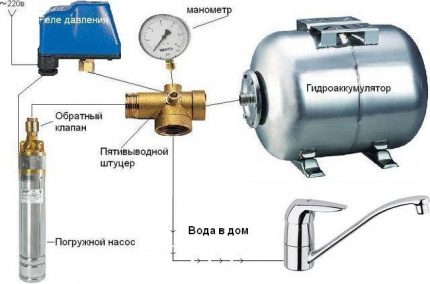
The devices are adapted for convenient installation and maintenance of the pumping station. Most often they are fixed by a fitting at the entrance accumulator, but can be mounted in the pipe of the HVS system in close proximity to the device.
Design and principle of operation
The pressure control relay has a simple collapsible design, thanks to which the user can independently adjust the operation of the accumulator, narrow or expand the parameters.
The internal parts are arranged in a durable plastic case that resembles an irregularly shaped box. It has a smooth surface and only 3 external working elements: two sleeve clamps for power cables coming from the mains and pump, and a metal pipe ¼, ½, 1 inch for connection to the system. The thread on the nozzle is both external and internal.
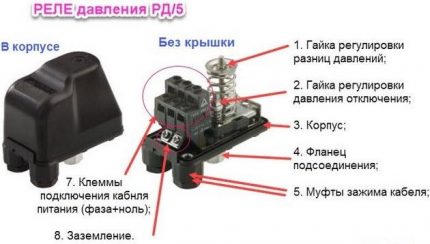
Inside there is a base to which working elements are attached: large and small springs with adjusting nuts, contacts for connection, a membrane and a plate that changes its position depending on the increase / decrease of the pressure parameters in the system.
The contacts of two electrical circuits, which are closed when the pressure limits are reached, are located under the springs, which are mounted on a metal plate. When the pressure rises, the membrane of the hydraulic tank is deformed, the pressure inside the pear increases, the mass of water presses on the plate. That, in turn, begins to act on a large spring.
When compressed, the spring trips and opens the contact that supplies voltage to the motor. As a result, the pumping station is switched off. With a decrease in pressure (usually in the range of 1.4 - 1.6 bar), the plate rises to its original position and the contacts close again - the motor starts to work and pumps water.
When buying a new pumping station, it is recommended to test equipment to make sure that all components are operational. Checking the performance of the relay occurs in the sequence described below. As an example, the Haitun PC-19 model.
Mechanical models do not have an indication and control panel, however, they can be equipped with a force button. It is necessary to make it function.
Relay selection criteria for the pump
There are many universal models that are sold separately from pumping stations and can be used to assemble the system yourself. When purchasing a relay or automation unit, it is necessary to rely on the characteristics of the device. They can be found in the technical documentation.
It is important that the capabilities of the relay match the characteristics of the capabilities of the rest of the equipment.
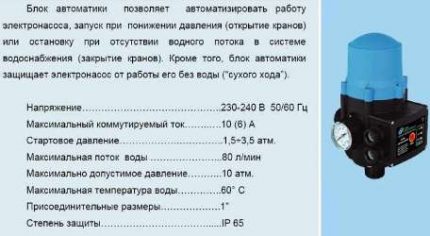
It should be based on the nominal pressure, but the upper limit of the working pressure is also important. It is necessary to take into account electrical indicators and the maximum temperature of the water. An obligatory parameter is the IP class, which indicates dust and moisture protection: the higher the value, the better.
The sizes of the connecting thread are indicated in inches: for example, ¼ inch or 1 inch. They must match the size of the fitting for connection. The dimensions and weight of the devices themselves are approximately the same and are secondary characteristics.
It should also be remembered that there are built-in and remote models. Most of the devices on sale are universal: they can be connected directly to hydraulic tank or mounted on a pipe.
Electronic relays have the same functions as mechanical ones: they are responsible for water supply and protect the pump mechanism from dry running. They are more moody than simple models, and are sensitive to suspended particles in water. To protect the device, a strainer strainer is installed in front of the connection point.
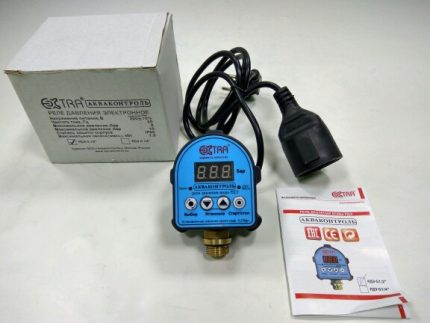
One of the differences from the traditional model is the delay in shutting down the pump. If the mechanical device responds quickly with increasing pressure, the electronic analogue turns off the equipment only after 10-15 seconds. This is explained by a careful attitude to technology: the less often the pump turns on / off, the longer it will last.
Some arrow models, as well as automation units, operate without a hydraulic accumulator, but their functionality is limited by simpler use. Suppose they are perfect for watering the garden or pumping liquid from one tank to another, but are not used in the water supply system of the house.
At the same time, the technical characteristics of the devices are the same as those of traditional relays: the factory setting is 1.5 atm., The trip threshold is 3 atm., The maximum value is 10 atm.
Reasons for Customizing
The collapsible design of the device and the setup instructions were invented for good reason. Factory parameters rarely meet the requirements of the water supply system, as well as the volume of the accumulator.
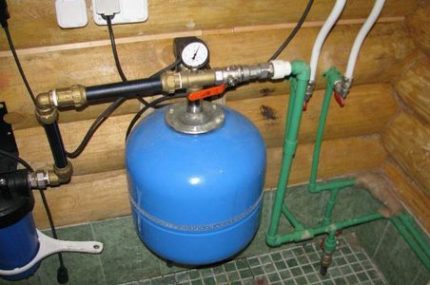
With the help of the setting, you can not only “adjust” the upper and lower limits to the optimal values, but also make the operation of the equipment more sparing - for example, reduce the number of on / off pumps. To do this, it is enough to slightly increase the range between working pressures - the delta.
You may encounter incorrect configuration of the factory model. If the delta is incorrectly coordinated and made too small, the pump will constantly turn on and off, responding to a minimum increase in parameters.
Instrument Adjustment Recommendations
By manipulating the springs, you can achieve a change in the threshold for turning off the pump, as well as adjust the volume of water in the accumulator tank. It is generally accepted that the larger the delta, the greater the volume of liquid in the tank. For example, with a delta of 2 atm. the tank is 50% filled with water, with a delta of 1 atm. - by 25%.
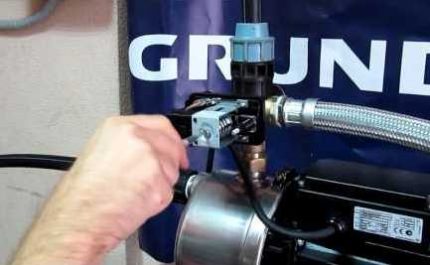
First, recall the general rules of adjustment:
- to increase the upper limit of operation, that is, to increase the shut-off pressure, tighten the nut on a large spring; to reduce the "ceiling" - weaken it;
- to increase the difference between the two pressure indicators, we tighten the nut on a small spring, to reduce the delta - weaken it;
- clockwise nut movement - increase in parameters, against - decrease;
- to configure, you need to connect a pressure gauge that shows the initial and changed parameters;
- Before starting the adjustment, it is necessary to clean the filters, fill the tank with water and make sure that all pumping equipment is working.
All adjustment actions are carried out only after testing the system and detecting poor performance or obvious errors in the work. It also happens that the station stops working due to a blockage that clogs the filter or one of the narrow nozzles. There is another article on our website where the process of adjusting the pressure switch is described in more detail - go linkto familiarize yourself with the material.
Practical relay setup examples
Let us examine the cases when a reference to the adjustment of the pressure switch is really necessary. This usually happens when you purchase a new device or when frequent pump shutdowns occur.
Also, setting up is required if you got a used device with lost parameters.
Connect a new device
At this stage, you should check how correct the factory settings are, and if necessary, make some changes to the pump.
To monitor the progress of work, it is recommended to record all the data received on a piece of paper. In the future, you can return to the initial settings or change the settings again.
The pump has stopped turning off
In this case, forcibly turn off the pumping equipment and act in the following order:
- We turn it on, and wait until the pressure reaches its maximum mark - suppose 3.7 atm.
- We turn off the equipment and lower the pressure by draining the water - for example, to 3.1 atm.
- Slightly tighten the nut on the small spring, increasing the differential value.
- We check how the shutdown pressure has changed and test the system.
- We adjust the best option by tightening and loosening the nuts on both springs.
If the reason was in the wrong initial configuration, it can be solved without buying a new relay. It is recommended that you check the operation of the pressure switch regularly, once every 1-2 months, and, if necessary, adjust the on / off limits.
Situations Not Requiring Adjustment
The reasons when the pump does not turn off or not turn on can be many - from clogging in communications to engine failure. Therefore, before you start disassembling the relay, you should make sure that the rest of the equipment of the pumping station is working properly.
If everything is in order with the other devices, the problem is in the automation. We proceed to the inspection of the pressure switch. We disconnect it from the fitting and wires, remove the cover and check two critical points: a thin connection pipe to the system and the contact block.
If cleaning measures did not help, and adjusting the position of the springs was also in vain, most likely the relay is not subject to further operation and should be replaced with a new one.
Suppose you got an old, but working device in your hands. Its adjustment takes place in the same order as setting up a new relay. Before starting work, verify the integrity of the device, disassemble it and check whether all contacts and springs are in place.
Conclusions and useful video on the topic
Practical video tips will help you better understand how to adjust the new pump station pressure switch if the parameters do not suit you for some reason. You will also learn how the dry running device is different.
Recommendations for setting up automation:
Professional tips for proper adjustment:
Comparative characteristic of two types of relays:
To correct the operation of the pressure switch, specialists are usually not invited, since this is a simple procedure that takes a little time.You can leave the factory settings, however, even minimal adjustment will help to prolong the operation of the pump and hydraulic tank, and also optimizes the work of the station.
Do you have personal experience in adjusting the relay for the pump and can you share practical advice with visitors to our site? Please leave your comments, ask questions, share your experience in the block below.

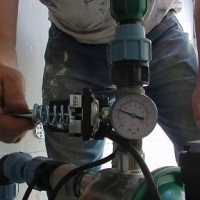 Water pressure switch: what it is, how it works + how it is adjusted
Water pressure switch: what it is, how it works + how it is adjusted  Connecting a pumping station to a well: rules for organizing autonomous water supply
Connecting a pumping station to a well: rules for organizing autonomous water supply 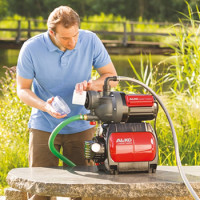 Adjustment of the pumping station: rules and algorithm for setting up the equipment
Adjustment of the pumping station: rules and algorithm for setting up the equipment 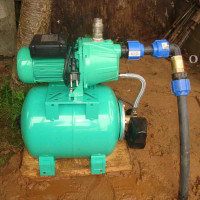 Ejector for a pumping station: operating principle, device, installation rules
Ejector for a pumping station: operating principle, device, installation rules 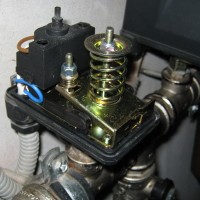 Adjusting the pressure switch for the accumulator: instructing on the equipment setup + expert advice
Adjusting the pressure switch for the accumulator: instructing on the equipment setup + expert advice 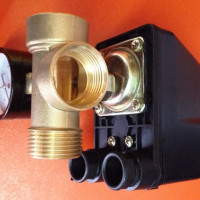 Connecting and adjusting the pressure switch for the pump: setup instructions
Connecting and adjusting the pressure switch for the pump: setup instructions  How much does it cost to connect gas to a private house: the price of organizing gas supply
How much does it cost to connect gas to a private house: the price of organizing gas supply  The best washing machines with dryer: model rating and customer tips
The best washing machines with dryer: model rating and customer tips  What is the color temperature of light and the nuances of choosing the temperature of the lamps to suit your needs
What is the color temperature of light and the nuances of choosing the temperature of the lamps to suit your needs  Replacement of a geyser in an apartment: replacement paperwork + basic norms and requirements
Replacement of a geyser in an apartment: replacement paperwork + basic norms and requirements
The pressure switch in the pumping station is one of the wearing parts. Self-diagnosis and repair operations are prohibited! However, the cause of system malfunctions is not always the device malfunction. I had a case when the pump did not give out the necessary volume of water, the relay constantly worked, turning off the pumping. After reading a couple of articles on the Internet, I decided that the reason was in the accumulator. Having disassembled the tank, I realized that the membrane was damaged, as a result of which water got into the air chamber. He drained the water, changed the pear, now the order - the pump is working. True, the relay remained in stock, bought for a replacement, although the old one worked for more than 5 years and continues to function properly.
Where was this information when I did it all in my country house) Although I used some sources from the Internet with my son, I don’t remember which ones. Everything turned out awry. The relays were installed in almost a couple of hours. But nothing worked, since the pressure was not taken into account, and in our device there was no protection against “dry running”. It is urgent now to take the electronic relay and install. Tell me the price.
You left too little input, even if you wrote what kind of pumping station you have. Look at the Danfoss relay, I bought for about 3,000 a few years ago.